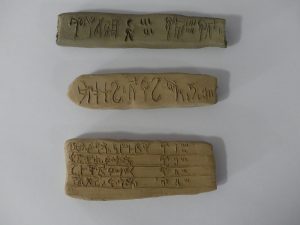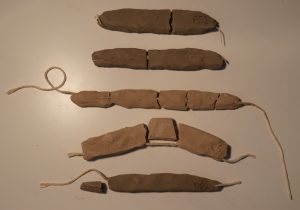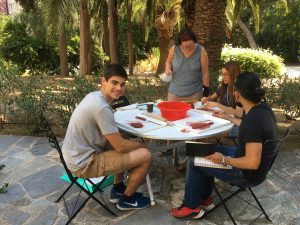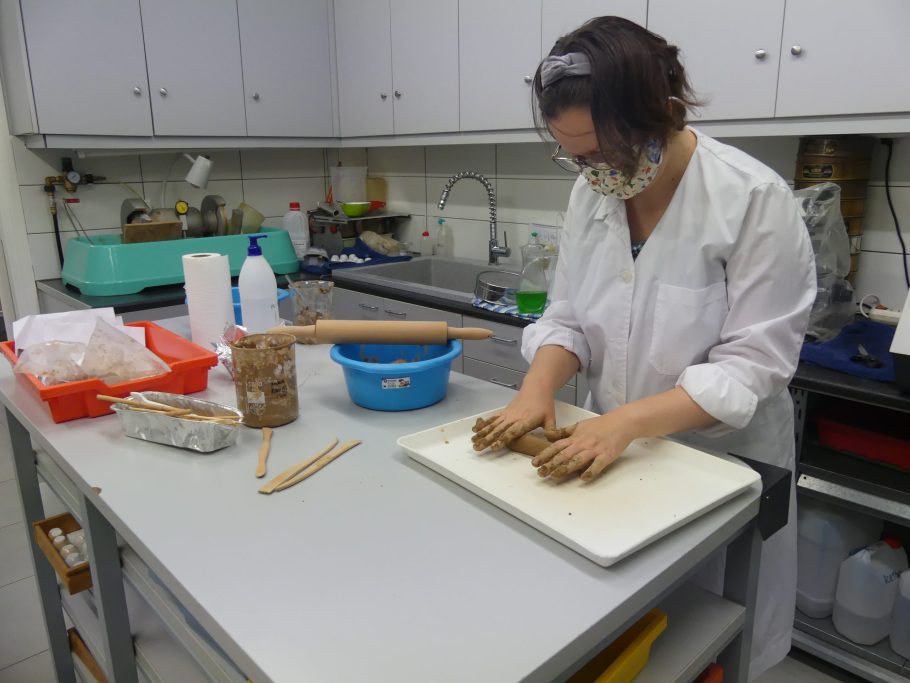Making Linear B Tablets
Anna P. Judson, who recently finished her Marie Skłodowska-Curie Fellow at the BSA, reports on her experimental work in the Fitch Laboratory into how the Linear B tablets from Late Bronze Age Pylos were made.
My research focuses on the Linear B texts – administrative inscriptions written on clay tablets in Late Bronze Age sites such as Knossos, Pylos, Mycenae, and Thebes – and in particular on the practices of their writers: I’m interested in how features of the texts such as handwriting, spelling, or text formatting can be used to reconstruct the activities of the writers, the way they were trained, and the kinds of choices they were making while creating their documents. However, the Linear B tablets are material objects as well as texts, and collecting and processing clay and then shaping it into a suitable form was just as important a part of the document production process as inscribing the text. (Unlike the pottery that most Fitch researchers study, the tablets were not fired, only air-dried – until their accidental firing when the rooms they were kept in burned down).
There’s some debate about whether tablets would have been made by the writers themselves, or by other people (assistants? or apprentices?). The evidence for this, based on identifying matching palm-prints left by the tablet-makers on different tablets and then comparing this to the writer’s handwriting, is inconclusive, and I suspect that both writers and assistants may have made tablets at different times. By experimenting with making tablets myself, I was aiming to better understand the physical effects of different methods which can be observed in the actual tablets, and therefore the motivations which might have underlain the decision to use a particular method. Whether this decision was made by the tablet’s writer or not, understanding these motivations would shed more light on the interactions between the ‘making’ and ‘writing’ stages of the administrative recording process.

Linear B tablet replicas (photo: A.P. Judson)
The Fitch provided me with samples of three types of clay – one fine and two coarser – and after grinding each of them up and adding water, I was ready to start experimenting. In principle, making a clay tablet is pretty straightforward: take some clay, roll or squash it into roughly the right shape, job done. However, the Mycenaean tablet-makers generally took a lot more care than that – not just making sure the tablet was an appropriate size and shape for the text that would be written on it, but smoothing the writing surface, neatening the edges, and so on. In addition, some tablets were made by flattening out a sheet of clay and then folding it up – we can see seams where the edges were joined, or folds on the ends of the tablets. In my experiments, I found that this was a much more fiddly way of making tablets – especially with coarser and/or drier clay, the edges were prone to cracking when folded – but that its effect was to increase the stability of the tablet once it had been made, while the clay was still fairly wet. After drying enough that the tablets could no longer be easily inscribed, no difference was visible: this method was therefore not meant to increase tablets’ long-term stability, but to reduce the risk of the wet tablet bending or breaking in the process of handling or writing on it. Some tablets also had a piece of straw or string inserted lengthwise through the middle – the straw/string does not survive, but we can see the channel it left through the clay. This has also been suggested to increase the tablet’s stability, but my experiments showed that it had a fairly small effect compared to folding; however, the straw/string was very effective when I tested another suggested function: keeping together fragments of tablets which broke during transportation (in my case, from Athens to the UK and back again, via an experimental archaeology panel I organised at the Classical Association conference).

Broken tablets mostly held together by string (photo: A.P. Judson)

Anna helping students make tablets (photo: M. Loy)
My results have demonstrated that, whether or not the tablet-makers and writers were the same people, there was clearly a close connection between the two stages of the process, with makers creating their tablets in accordance with the needs of the writers as well as the tablets’ future uses within the palace’s administrative system. I was also able to put my experience in tablet-making to good use on the recent Postgraduate Course in Linear B and Mycenaean Greek, in which participants made and inscribed their own tablets and then prepared ‘publications’ of their ‘newly-discovered’ tablets! Making tablets is always a fun activity, and the BSA website now also hosts a video in which I talk about my experiments, along with a worksheet (in English and Greek) to try making and writing your own. It’s particularly aimed at schools but is suitable for anyone who feels like playing with clay and giving Linear B tablet-making a go!
Anna P. Judson
Anna can be contacted by email, Twitter, or her blog.
This research was carried out as part of the project “Writing at Pylos (WRAP): palaeography, tablet production and the work of the Mycenaean scribes”. This project has received funding from the European Union’s Horizon 2020 research and innovation programme under the Marie Skłodowska-Curie grant agreement No 885977.
